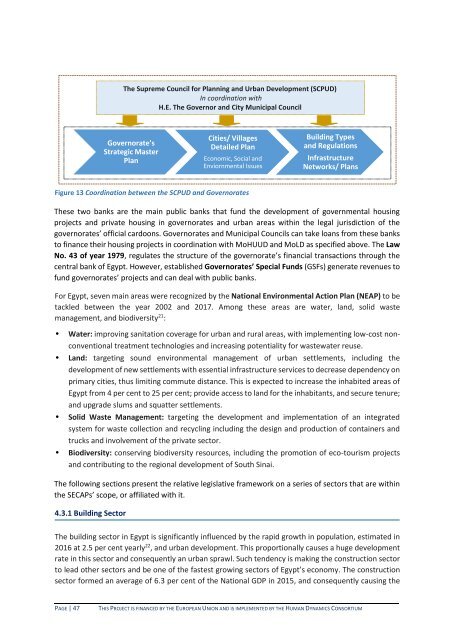180917_CES-MED_National_Report_Egypt_FINAL2rev
Create successful ePaper yourself
Turn your PDF publications into a flip-book with our unique Google optimized e-Paper software.
The Supreme Council for Planning and Urban Development (SCPUD)<br />
In coordination with<br />
H.E. The Governor and City Municipal Council<br />
Governorate's<br />
Strategic Master<br />
Plan<br />
Cities/ Villages<br />
Detailed Plan<br />
Economic, Social and<br />
Enviornmental Issues<br />
Building Types<br />
and Regulations<br />
Infrastructure<br />
Networks/ Plans<br />
Figure 13 Coordination between the SCPUD and Governorates<br />
These two banks are the main public banks that fund the development of governmental housing<br />
projects and private housing in governorates and urban areas within the legal jurisdiction of the<br />
governorates’ official cardoons. Governorates and Municipal Councils can take loans from these banks<br />
to finance their housing projects in coordination with MoHUUD and MoLD as specified above. The Law<br />
No. 43 of year 1979, regulates the structure of the governorate’s financial transactions through the<br />
central bank of <strong>Egypt</strong>. However, established Governorates’ Special Funds (GSFs) generate revenues to<br />
fund governorates’ projects and can deal with public banks.<br />
For <strong>Egypt</strong>, seven main areas were recognized by the <strong>National</strong> Environmental Action Plan (NEAP) to be<br />
tackled between the year 2002 and 2017. Among these areas are water, land, solid waste<br />
management, and biodiversity 21 :<br />
• Water: improving sanitation coverage for urban and rural areas, with implementing low-cost nonconventional<br />
treatment technologies and increasing potentiality for wastewater reuse.<br />
• Land: targeting sound environmental management of urban settlements, including the<br />
development of new settlements with essential infrastructure services to decrease dependency on<br />
primary cities, thus limiting commute distance. This is expected to increase the inhabited areas of<br />
<strong>Egypt</strong> from 4 per cent to 25 per cent; provide access to land for the inhabitants, and secure tenure;<br />
and upgrade slums and squatter settlements.<br />
• Solid Waste Management: targeting the development and implementation of an integrated<br />
system for waste collection and recycling including the design and production of containers and<br />
trucks and involvement of the private sector.<br />
• Biodiversity: conserving biodiversity resources, including the promotion of eco-tourism projects<br />
and contributing to the regional development of South Sinai.<br />
The following sections present the relative legislative framework on a series of sectors that are within<br />
the SECAPs’ scope, or affiliated with it.<br />
4.3.1 Building Sector<br />
The building sector in <strong>Egypt</strong> is significantly influenced by the rapid growth in population, estimated in<br />
2016 at 2.5 per cent yearly 22 , and urban development. This proportionally causes a huge development<br />
rate in this sector and consequently an urban sprawl. Such tendency is making the construction sector<br />
to lead other sectors and be one of the fastest growing sectors of <strong>Egypt</strong>’s economy. The construction<br />
sector formed an average of 6.3 per cent of the <strong>National</strong> GDP in 2015, and consequently causing the<br />
PAGE | 47<br />
THIS PROJECT IS FINANCED BY THE EUROPEAN UNION AND IS IMPLEMENTED BY THE HUMAN DYNAMICS CONSORTIUM

















